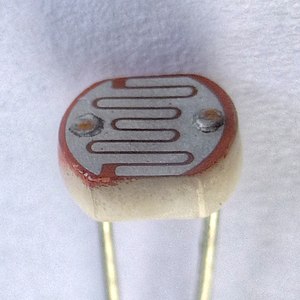Photoresistor
Light-sensitive resistor
{{ infobox
| title = Photoresistor
| image = {{#if:|[[File:|image=|size=|sizedefault=frameless|alt=}} | caption =
| label1 = Type | data1 = Passive | label2 = Working principle | data2 = Photoconductivity | label3 = Inventor | data3 = | label4 = Invention year | data4 = | label5 = First production | data5 = | label6 = Number of terminals | data6 = | label7 = Pin names | data7 = 2 | label8 = Linear? | data8 =
| header9 = | data10 = }}
A photoresistor, also known as a light-dependent resistor (LDR), is a passive electronic component whose resistance decreases with increasing incident light intensity. It is a type of resistor whose resistance varies significantly with the amount of light falling on its surface.
Working Principle[edit | edit source]
The working principle of a photoresistor is based on photoconductivity, which is an optical phenomenon in which the material's conductivity is increased when it absorbs electromagnetic radiation, such as visible light. When light falls on the photoresistor, the number of charge carriers increases, leading to a decrease in resistance.
Materials[edit | edit source]
Photoresistors are typically made from semiconductor materials such as cadmium sulfide (CdS) or cadmium selenide (CdSe). These materials have properties that make them sensitive to light, allowing them to change their resistance based on the intensity of the light.
Applications[edit | edit source]
Photoresistors are used in various applications, including:
Advantages and Disadvantages[edit | edit source]
Advantages[edit | edit source]
- Simple and inexpensive
- Easy to use in analog circuits
- Wide range of resistance values
Disadvantages[edit | edit source]
- Slow response time compared to other light sensors
- Sensitivity to temperature changes
- Limited spectral response
Related Components[edit | edit source]
See Also[edit | edit source]
Related Pages[edit | edit source]
Search WikiMD
Ad.Tired of being Overweight? Try W8MD's physician weight loss program.
Semaglutide (Ozempic / Wegovy and Tirzepatide (Mounjaro / Zepbound) available.
Advertise on WikiMD
|
WikiMD's Wellness Encyclopedia |
| Let Food Be Thy Medicine Medicine Thy Food - Hippocrates |
Translate this page: - East Asian
中文,
日本,
한국어,
South Asian
हिन्दी,
தமிழ்,
తెలుగు,
Urdu,
ಕನ್ನಡ,
Southeast Asian
Indonesian,
Vietnamese,
Thai,
မြန်မာဘာသာ,
বাংলা
European
español,
Deutsch,
français,
Greek,
português do Brasil,
polski,
română,
русский,
Nederlands,
norsk,
svenska,
suomi,
Italian
Middle Eastern & African
عربى,
Turkish,
Persian,
Hebrew,
Afrikaans,
isiZulu,
Kiswahili,
Other
Bulgarian,
Hungarian,
Czech,
Swedish,
മലയാളം,
मराठी,
ਪੰਜਾਬੀ,
ગુજરાતી,
Portuguese,
Ukrainian
Medical Disclaimer: WikiMD is not a substitute for professional medical advice. The information on WikiMD is provided as an information resource only, may be incorrect, outdated or misleading, and is not to be used or relied on for any diagnostic or treatment purposes. Please consult your health care provider before making any healthcare decisions or for guidance about a specific medical condition. WikiMD expressly disclaims responsibility, and shall have no liability, for any damages, loss, injury, or liability whatsoever suffered as a result of your reliance on the information contained in this site. By visiting this site you agree to the foregoing terms and conditions, which may from time to time be changed or supplemented by WikiMD. If you do not agree to the foregoing terms and conditions, you should not enter or use this site. See full disclaimer.
Credits:Most images are courtesy of Wikimedia commons, and templates Wikipedia, licensed under CC BY SA or similar.
Contributors: Prab R. Tumpati, MD

